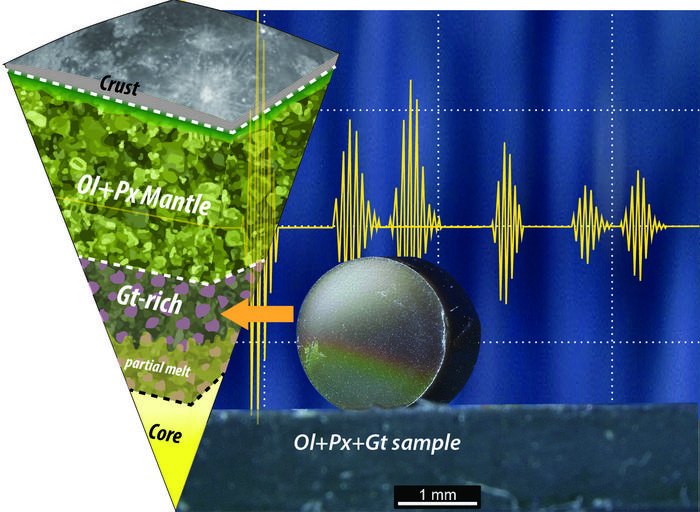Our present-day Moon has an interior structure containing a central metallic core, overlain by a mantle comprised of minerals such as olivine and pyroxene (e.g. Ol+Px mantle) underneath a shell of crust (e.g. Wieczorek et al. 2006). Such a picture of the Moon’s interior has been formed from analyses of returning lunar samples and records of deep seismic events collected during missions to the Moon (e.g. Weber et al., 2011). Despite the wealth of literature, there is still a longstanding debate as to the existence of garnet (Gt) within the deeper part of the lunar mantle. Reflecting upon the existence of garnet, the pivotal question first posited fifty years ago (e.g. Anderson, 1975) has remained unanswered: are laboratory measured sound velocities in realistic lunar aggregates containing garnet compatible with the seismic profiles of the deep lunar interior?

Credit: Geodynamics Research Center, Ehime University
Our present-day Moon has an interior structure containing a central metallic core, overlain by a mantle comprised of minerals such as olivine and pyroxene (e.g. Ol+Px mantle) underneath a shell of crust (e.g. Wieczorek et al. 2006). Such a picture of the Moon’s interior has been formed from analyses of returning lunar samples and records of deep seismic events collected during missions to the Moon (e.g. Weber et al., 2011). Despite the wealth of literature, there is still a longstanding debate as to the existence of garnet (Gt) within the deeper part of the lunar mantle. Reflecting upon the existence of garnet, the pivotal question first posited fifty years ago (e.g. Anderson, 1975) has remained unanswered: are laboratory measured sound velocities in realistic lunar aggregates containing garnet compatible with the seismic profiles of the deep lunar interior?
To provide answers to this question Ehime’s researchers first synthesized garnet-rich lunar rock assemblages (Ol+Px+Gt sample) at high pressures and high temperatures using the multi-anvil press apparatus “ORANGE-2000” at the Geodynamics Research Center. These samples were then transported to SPring-8, the Large-scale Synchrotron Radiation Facility, located in Hyogo Prefecture, where experiments were carried out at the High Pressure and High Temperature beamline BL04B1. Here the researchers subjected the lunar rock assemblage to pressure and temperature conditions similar to those of the Moon’s deep interior while they measured the propagation speed of sound waves in the lunar rock assemblage. Combining the results of their experiment with a modelling component, the researchers concluded that the sound velocities in lunar assemblages containing large amounts of garnet were compatible with the seismic and density profiles of the Moon’s deep interior, between depths of 740-1260 km. Furthermore, they found that rock assemblages containing little to no garnet are unlikely to explain the observed seismic velocities and densities of the lunar mantle at those depths.
These intriguing results have significant implications for the Moon and its interior dynamics, including its composition and formation (e.g. Jing et al., 2022), the interior temperature, as well as implications for the lunar core and the now defunct lunar dynamo.
Journal
Earth and Planetary Science Letters



